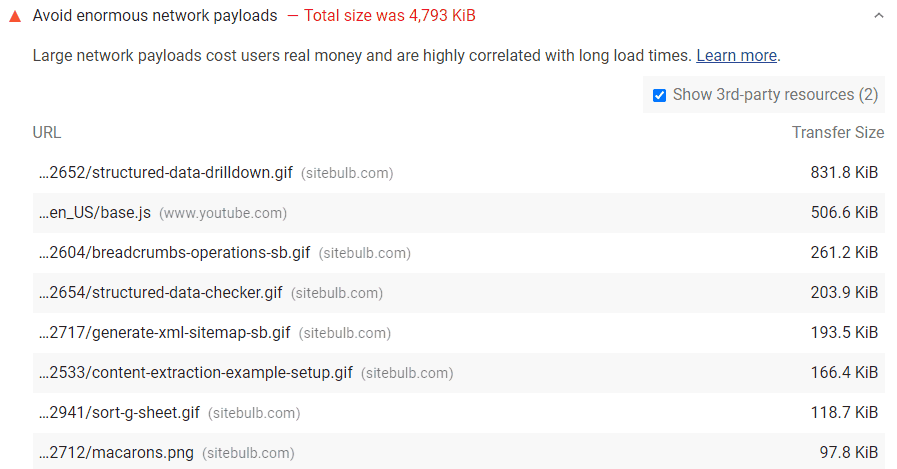Avoid enormous network payloads
This means that the URL has an extremely large page size (over 4Mb), which makes it slow to download.
Why is this important?
A large page size is due to lots of page resources or very large page resources (e.g. unoptimized images), which translates into a large network payload when a browser requests the page. This takes the browser longer to download and process the page resources, and therefore longer to render the page.
What does the Hint check?
This Hint will trigger for any internal URL whose total network requests exceed 4,096 KiB.
How do you resolve this issue?
When tackling pages with enormous payloads, you want to concentrate your efforts on the largest page resources, which will have a greater impact upon the overall payload.
You can decrease the overall page size by optimizing in a number of ways:
- Properly size images
- Compress images or serve images in a next-gen format (e.g. WebP)
- Minify CSS
- Minify JavaScript
- Defer requests until they're needed
You may notice that all of these suggestions are actually already Performance Hints (the links above are to each Hint page), so it is likely that you can improve network payloads in general by working on some of these other optimizations.
In general you should aim to keep your total byte size below 1,600 KiB. This target is based on the amount of data that can be theoretically downloaded on a 3G connection while still achieving a Time to Interactive of 10 seconds or less.
It will require a developer working closely with the code, and a diagnostic tool like Lighthouse, to assess which resources can be optimized in this way. The links below provide some examples and workflows.
In Lighthouse, the equivalent diagnostic highlights the largest page resources in terms of file size:

Further Reading
- Avoid enormous network payloads (Lighthouse documentation)
- How To Avoid Enormous Network Payloads In WordPress
 Sitebulb Desktop
Sitebulb Desktop
Find, fix and communicate technical issues with easy visuals, in-depth insights, & prioritized recommendations across 300+ SEO issues.
- Ideal for SEO professionals, consultants & marketing agencies.
 Sitebulb Cloud
Sitebulb Cloud
Get all the capability of Sitebulb Desktop, accessible via your web browser. Crawl at scale without project, crawl credit, or machine limits.
- Perfect for collaboration, remote teams & extreme scale.